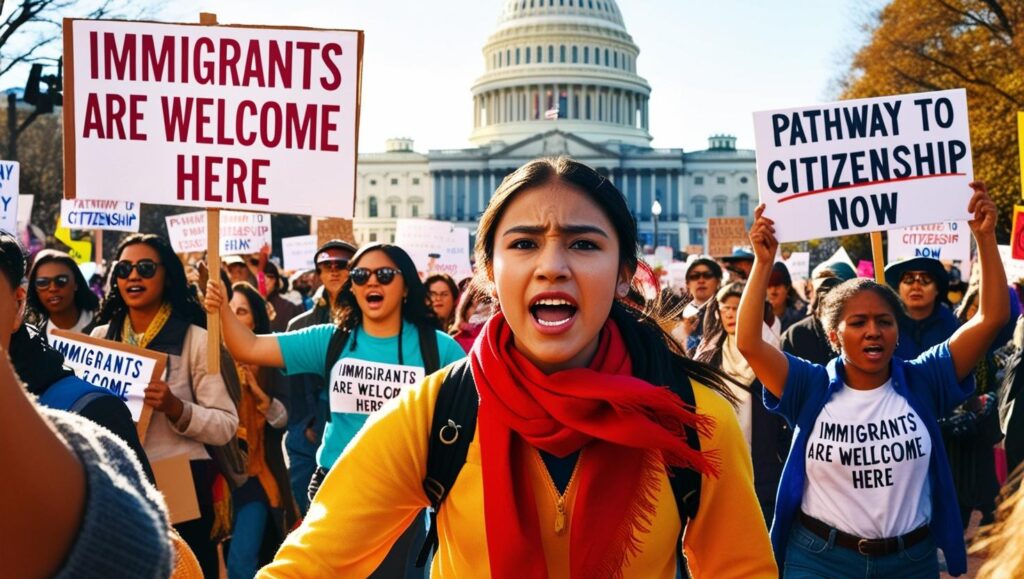Immigration has always been a cornerstone of the United States’ identity, shaping its culture, economy, and global influence. However, the complexities of American immigration laws and policies often leave individuals—both immigrants and citizens—confused about their rights, responsibilities, and the processes involved. In this three-part blog series, we’ll break down the key aspects of U.S. immigration, focusing on the legal framework, the role of agencies like USCIS, and the challenges faced by immigrants today.
The Foundations of Immigration Law in the United States
The immigration system in the United States is governed by a complex web of federal laws, policies, and regulations. At its core is the Immigration and Nationality Act (INA), which was enacted in 1952 and has since undergone numerous amendments to address evolving immigration issues. The INA serves as the backbone of U.S. immigration law, outlining the rules for legal immigration, visa programs, and the process of obtaining lawful permanent residence.
The Immigration and Nationality Act (INA)
The INA allows the United States to grant visas to individuals based on family relationships, employment, humanitarian needs, and diversity. It also establishes quotas for the annual admission of U.S. permanent immigrant visas each year, ensuring a structured approach to immigration. However, critics argue that these quotas are outdated and fail to meet the demands of modern immigration needs.
For example, the Immigration Act of 1990, a significant amendment to the INA, increased the number of employment-based visas and introduced the Diversity Visa Lottery Program. This program aims to promote immigration from underrepresented countries, offering 55,000 visas annually to individuals from nations with low rates of immigration to the United States.
The Role of USCIS in the Immigration System
The U.S. Citizenship and Immigration Services (USCIS) is the federal agency responsible for overseeing lawful immigration to the United States. As part of the Department of Homeland Security (DHS), USCIS handles everything from processing immigrant visas to granting lawful permanent residence (commonly known as a green card) and naturalization for those seeking U.S. citizenship.
Key Functions of USCIS
- Visa Processing: USCIS processes applications for both immigrant and non-immigrant visas, including work visas, family-based visas, and humanitarian visas.
- Green Cards: The agency manages applications for permanent residence, allowing individuals to live and work in the United States indefinitely.
- Naturalization: USCIS oversees the process of granting U.S. citizenship to eligible immigrants who meet residency and other requirements.
- DACA and Humanitarian Protections: Programs like Deferred Action for Childhood Arrivals (DACA), which protects undocumented immigrants brought to the U.S. as children, fall under USCIS’s jurisdiction.
Despite its critical role, USCIS has faced criticism for delays in processing times, backlogs, and inconsistent policies, particularly during the Trump administration, which implemented stricter immigration enforcement measures.

Legal Immigration vs. Illegal Immigration
One of the most contentious issues in U.S. immigration policy is the distinction between legal immigration and illegal immigration. While legal immigration involves following established processes to obtain visas or green cards, illegal immigration refers to entering or remaining in the United States without proper authorization.
Legal Immigration: Pathways and Challenges
Legal immigration to the United States typically falls into three main categories:
- Family-Based Immigration: U.S. citizens and lawful permanent residents can sponsor certain relatives to immigrate to the United States.
- Employment-Based Immigration: Employers can sponsor foreign workers for specific jobs, often through programs like the H-1B visa.
- Humanitarian Immigration: Refugees, asylum seekers, and individuals fleeing persecution in their home countries may be granted protection under U.S. law.
However, the legal immigration system is not without its challenges. Long wait times, limited visa availability, and complex eligibility requirements often make it difficult for individuals to navigate the process. For instance, some family-based visa categories have wait times of over 20 years, particularly for applicants from countries like Mexico and the Philippines.
Illegal Immigration: Causes and Consequences
Illegal immigration remains a polarizing issue in the United States. According to the American Immigration Council, there are an estimated 11 million undocumented immigrants currently living in the U.S. Many of these individuals entered the country legally but overstayed their visas, while others crossed the Mexico–United States border without authorization.
The reasons for illegal immigration are varied, ranging from economic opportunities to escaping violence in Central American countries. However, the consequences can be severe, including deportation, detention, and limited access to basic rights and services.
Immigration Enforcement and the Role of ICE
The enforcement of U.S. immigration laws falls primarily under the jurisdiction of Immigration and Customs Enforcement (ICE), another agency within the Department of Homeland Security. ICE is tasked with identifying, detaining, and deporting individuals who violate immigration laws.
Controversies Surrounding ICE
ICE has been at the center of numerous controversies, particularly regarding its treatment of undocumented immigrants and the use of detention facilities. During the Trump administration, the agency faced widespread criticism for its family separation policy, which resulted in thousands of children being separated from their parents at the border.
The Biden administration has sought to reform immigration enforcement by prioritizing the deportation of individuals who pose a threat to public safety or national security. However, critics argue that more comprehensive reforms are needed to address the root causes of illegal immigration and improve the treatment of detainees.

Immigration Courts and the Path to Justice
For immigrants facing deportation or seeking asylum, the immigration court system plays a crucial role in determining their fate. These courts, overseen by the Executive Office for Immigration Review (EOIR) under the Department of Justice, handle cases related to removal proceedings, asylum claims, and appeals.
Challenges in Immigration Courts
The U.S. immigration court system is notoriously overburdened, with a backlog of over 1.5 million cases as of 2024. This backlog often results in years-long delays for immigrants awaiting their hearings. Additionally, the lack of legal representation for many immigrants—particularly those in detention—further complicates their ability to navigate the system.
A Brief History of U.S. Immigration Policy
The immigration policy of the United States has evolved significantly over the past two centuries, reflecting the country’s shifting economic, social, and political priorities. From the open-door policies of the 19th century to the restrictive measures of the 20th and 21st centuries, U.S. immigration laws have been shaped by a combination of inclusion and exclusion.
Early Immigration Policies
In the early years of the United States, immigration was largely unrestricted. Millions of immigrants from Europe arrived in the 19th century, seeking economic opportunities and freedom. However, as the immigrant population grew, so did concerns about assimilation and competition for jobs.
The first major restriction came with the Chinese Exclusion Act of 1882, which barred Chinese laborers from entering the United States. This marked the beginning of a series of racially and ethnically motivated immigration laws, including the Immigration Act of 1924, which established quotas based on national origin and heavily favored immigrants from Western Europe.
The Immigration and Nationality Act of 1965
A turning point in U.S. immigration policy came with the Immigration and Nationality Act of 1965, which abolished the national origins quota system and prioritized family reunification and skilled labor. This landmark legislation paved the way for increased immigration from Asia, Latin America, and Africa, transforming the demographic makeup of the United States.
Modern Immigration Reforms
In recent decades, U.S. immigration policy has been marked by efforts to balance security concerns with the need for comprehensive reform. Key legislative milestones include:
- The Immigration Reform and Control Act of 1986, which granted amnesty to millions of undocumented immigrants while imposing penalties on employers who hired unauthorized workers.
- The Immigration Act of 1990, which expanded employment-based visas and introduced the Diversity Visa Lottery Program.
- The Deferred Action for Childhood Arrivals (DACA) program, introduced by the Obama administration in 2012, which provides temporary protection from deportation for undocumented immigrants brought to the U.S. as children.
Despite these efforts, significant immigration reform legislation has not been enacted in decades, leaving many issues unresolved.

The Impact of Recent Administrations on Immigration Policy
The past two administrations—the Trump administration and the Biden administration—have taken starkly different approaches to immigration policy, reflecting the deep political divide on this issue.
The Trump Administration’s Immigration Policies
The Trump administration implemented some of the most restrictive immigration policies in recent history, focusing on immigration enforcement and border security. Key measures included:
- The “zero-tolerance” policy, which led to the separation of thousands of families at the Mexico–United States border.
- The travel ban targeting several predominantly Muslim countries, which was widely criticized as discriminatory.
- Reductions in refugee admissions and the termination of programs like Temporary Protected Status (TPS) for certain countries.
- Efforts to end DACA, which were ultimately blocked by the courts.
These policies sparked widespread protests and legal challenges, highlighting the contentious nature of immigration in the United States.
The Biden Administration’s Approach
In contrast, the Biden administration has sought to reverse many of the restrictive measures implemented by its predecessor. Key actions include:
- Reinstating and expanding DACA protections.
- Ending the family separation policy and increasing oversight of immigration detention facilities.
- Proposing a comprehensive immigration plan that includes a pathway to citizenship for millions of undocumented immigrants already in the United States.
- Increasing the annual cap on refugee admissions.
However, the Biden administration has faced criticism from both sides of the political spectrum. While some argue that the administration has not done enough to address the root causes of illegal immigration, others believe that its policies are too lenient and encourage unauthorized border crossings.

Challenges Facing the U.S. Immigration System
The U.S. immigration system is plagued by numerous challenges, from outdated laws to administrative inefficiencies. These issues not only affect immigrants but also have broader implications for the country’s economy, security, and social fabric.
The Backlog Crisis
One of the most pressing issues is the backlog of immigration cases. As of 2024, the Executive Office for Immigration Review (EOIR) reported a backlog of over 1.5 million cases in immigration courts, with some immigrants waiting years for their hearings. Similarly, USCIS faces significant delays in processing applications for visas, green cards, and citizenship.
These delays can have devastating consequences for immigrants, who may be unable to work, reunite with their families, or access basic services while their cases are pending.
Border Security and Immigration Enforcement
The Mexico–United States border remains a focal point of the immigration debate. While some advocate for increased border security to prevent unauthorized crossings, others argue that addressing the root causes of migration—such as poverty and violence in Central American countries—is a more effective solution.
The role of Immigration and Customs Enforcement (ICE) in enforcing immigration laws has also come under scrutiny. Critics have called for reforms to ensure that enforcement measures are humane and prioritize public safety over mass deportations.
The Need for Comprehensive Immigration Reform
Despite decades of debate, the United States has yet to enact comprehensive immigration reform. Key issues that need to be addressed include:
- Modernizing the legal immigration system to reduce wait times and increase visa availability.
- Providing a pathway to citizenship for undocumented immigrants who have lived in the United States for at least five years.
- Balancing border security with humanitarian protections for asylum seekers and refugees.
- Ensuring that immigration policies align with the country’s economic and labor needs.
Without significant reform, the U.S. immigration system will continue to face challenges that undermine its effectiveness and fairness.

The Human Impact of Immigration Policies
Behind the statistics and policy debates are the stories of millions of individuals and families whose lives are shaped by U.S. immigration laws. From the spouses and children of immigrants seeking reunification to asylum seekers fleeing persecution in their home countries, the human impact of immigration policies cannot be overstated.
Stories of Resilience
Immigrants have long been a source of resilience and innovation in the United States. Many have overcome significant obstacles to build better lives for themselves and their families, contributing to the country’s economy and culture in the process.
For example, permanent residents who obtain green cards often go on to become U.S. citizens, participating fully in American society and even serving in the military. Similarly, recipients of programs like DACA have pursued higher education, started businesses, and become advocates for their communities.
The Role of Advocacy Organizations
Organizations like the American Immigration Council and the American Immigration Lawyers Association play a crucial role in supporting immigrants and advocating for fair and just immigration policies. These groups provide legal assistance, conduct research, and work to raise awareness about the challenges facing immigrants in the United States.
The Case for Comprehensive Immigration Reform
The need for comprehensive immigration reform has been a recurring theme in U.S. politics for decades. While various administrations have proposed reforms, none have successfully addressed the systemic issues plaguing the immigration system.
What Would Comprehensive Immigration Reform Look Like?
Comprehensive immigration reform would aim to address the following key areas:
- Modernizing the Legal Immigration System
- Increase the number of permanent immigrant visas each year to meet the demands of the U.S. economy and reunite families more quickly.
- Streamline the visa application process to reduce delays and backlogs.
- Update the employment-based visa system to better align with labor market needs, particularly in industries facing worker shortages.
- Providing a Pathway to Citizenship
- Create a pathway to citizenship for the estimated 11 million undocumented immigrants already in the United States, provided they meet certain requirements such as paying taxes, passing background checks, and demonstrating long-term residency.
- Expand protections for individuals under programs like Deferred Action for Childhood Arrivals (DACA) and Temporary Protected Status (TPS).
- Balancing Border Security and Humanitarian Protections
- Invest in technology and infrastructure to enhance border protection while ensuring that enforcement measures are humane and respect the rights of asylum seekers.
- Address the root causes of migration from Central American countries by providing economic aid and supporting anti-corruption efforts.
- Improving Immigration Enforcement
- Reform agencies like Immigration and Customs Enforcement (ICE) to prioritize the deportation of individuals who pose a threat to public safety or national security.
- Increase oversight of immigration detention facilities to ensure humane treatment of detainees.
- Reducing the Immigration Court Backlog
- Hire more immigration judges and support staff to handle the growing number of cases.
- Expand access to legal representation for immigrants, particularly those in detention or facing deportation.

The Role of Technology in Modernizing the Immigration System
Technology has the potential to revolutionize the way the immigration system works, making it more efficient, transparent, and accessible. Here are some ways technology could be leveraged to improve U.S. immigration processes:
Digital Case Management
The current paper-based system used by many immigration agencies is outdated and prone to errors. Transitioning to a fully digital case management system would allow applicants to track the status of their cases in real time, reducing uncertainty and frustration.
Artificial Intelligence for Application Processing
AI could be used to streamline the processing of visa and green card applications by automating routine tasks, such as verifying documents and flagging incomplete submissions. This would free up USCIS officers to focus on more complex cases, potentially reducing processing times.
Virtual Hearings in Immigration Courts
The use of virtual hearings could help alleviate the backlog in immigration courts by allowing judges to hear cases remotely. This would be particularly beneficial for immigrants in detention or those living in remote areas.
Enhanced Border Security Technology
Investing in advanced surveillance technology, such as drones and sensors, could improve border protection without the need for physical barriers. This approach would allow for more effective monitoring of the Mexico–United States border while minimizing the environmental and social impact of traditional border walls.
The Future of U.S. Immigration Policy
The future of immigration policy in the United States will depend on a combination of political will, public opinion, and global trends. Here are some key factors that could shape the direction of U.S. immigration policy in the coming years:
Political Landscape
Immigration has long been a divisive issue in U.S. politics, with Democrats and Republicans often taking opposing stances. While Democrats generally advocate for more inclusive policies, such as pathways to citizenship and expanded refugee admissions, Republicans tend to prioritize border security and stricter enforcement measures.
The outcome of the 2024 presidential election and subsequent congressional elections will play a significant role in determining the future of U.S. immigration policy. For example, a Democratic administration may push for comprehensive reform, while a Republican administration may focus on enforcement and reducing immigration levels.
Economic and Labor Market Needs
The U.S. economy relies heavily on immigrant labor, particularly in industries such as agriculture, healthcare, and technology. As the country faces an aging population and labor shortages in key sectors, there will likely be increased pressure to expand legal immigration pathways and attract skilled workers from abroad.
Global Migration Trends
Global events, such as conflicts, climate change, and economic instability, will continue to drive migration to the United States. For example, rising violence and poverty in Central American countries have contributed to an increase in asylum seekers at the southern border. Addressing these root causes will require international cooperation and targeted foreign aid.
Public Opinion and Advocacy
Public opinion on immigration is often shaped by media coverage, political rhetoric, and personal experiences. Advocacy organizations, such as the American Immigration Lawyers Association and the American Immigration Council, will play a crucial role in educating the public and pushing for fair and just immigration policies.

The Human Side of Immigration Reform
While policy debates often focus on statistics and legal frameworks, it’s important to remember the human stories behind immigration. Millions of individuals and families are directly impacted by U.S. immigration laws, and their experiences highlight the urgent need for reform.
Stories of Hope and Resilience
Consider the story of a DACA recipient who was brought to the United States as a child and has since graduated from college, started a business, and contributed to their community. Or the story of a refugee who fled persecution in their home country and found safety and opportunity in the United States. These stories remind us of the immense potential and resilience of immigrants.
The Role of Communities
Local communities play a vital role in supporting immigrants, from providing legal assistance to offering language classes and job training. By fostering a welcoming environment, communities can help immigrants integrate and thrive, benefiting society as a whole.
Conclusion: A Path Forward
The United States has long been a nation of immigrants, built on the contributions of individuals from around the world. However, the current immigration system is in dire need of reform to address the challenges of the 21st century.
By modernizing the legal immigration system, providing a pathway to citizenship for undocumented immigrants, and balancing security with humanitarian protections, the U.S. can create a fairer and more effective immigration policy. At the same time, leveraging technology and addressing the root causes of migration will be essential for building a sustainable system.
Ultimately, the future of U.S. immigration policy will depend on the collective efforts of policymakers, advocacy organizations, and communities. By working together, we can ensure that the United States remains a beacon of hope and opportunity for immigrants from around the world. If you are a national prodigy, work in the national interest, and possess extraordinary talent, you could apply for EB1A or EB2-NIW. We could help you with the entire letter writing process. Contact us to get started.

